Ant Removal
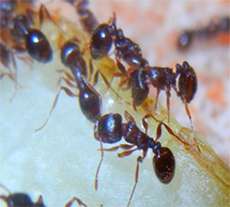 Ants are likely the most common insect pest that the home or business owner must deal with. They will infest virtually any type of structure or property and will adapt to different control methods. Proper identification of the ant species is a crucial step in determining control methods. Pavement Ants, Thief Ants, Odorous House Ants, Pharaoh Ants and Carpenter Ants are common pest species in Ontario. Please refer to our fact sheet on Carpenter Ants for more detailed information on this destructive ant species.
Ants are likely the most common insect pest that the home or business owner must deal with. They will infest virtually any type of structure or property and will adapt to different control methods. Proper identification of the ant species is a crucial step in determining control methods. Pavement Ants, Thief Ants, Odorous House Ants, Pharaoh Ants and Carpenter Ants are common pest species in Ontario. Please refer to our fact sheet on Carpenter Ants for more detailed information on this destructive ant species.
Appearance and Behaviour
Ants have a very visible three segmented body and can be black, brown, yellow or red. They are social insects that live in colonies and can vary in size from 1mm to 15mm depending on the species. The ant colony will consist of one or more queens and many worker ants. Ants are able to communicate with each other and will work together to feed and protect the colony. They will nest in the soil, in trees, in plants and in wood; also adapting to live in man-made materials.
Ants require a balanced diet of protein and carbohydrates and have a wide ranging diet. Plant nectar, honeydew, live and dead insects are all staples in the ant colony diet. The nest will send out worker ants to forage for food and carry it back to the nest. They leave a chemical trail of pheromones to direct other foraging ants to the food source. Regular cleaning and removal of food sources will disrupt their trail.
Control
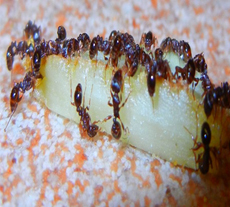 Control methods will vary greatly from species to species of ant, making identification a key step in solving an ant issue. While baiting can be sufficient for some species, with others it is completely ineffective. Chemical sprays and dusts will work well as nest and barrier treatments, when properly applied. Whenever possible, a coordinated interior/exterior treatment will provide the best results. Contact Protec Pest Control today to have your ant problem solved.
Control methods will vary greatly from species to species of ant, making identification a key step in solving an ant issue. While baiting can be sufficient for some species, with others it is completely ineffective. Chemical sprays and dusts will work well as nest and barrier treatments, when properly applied. Whenever possible, a coordinated interior/exterior treatment will provide the best results. Contact Protec Pest Control today to have your ant problem solved.
Bat Removal
Appearance and Behaviour
 The two common species of bats in Ontario are the Little Brown Bat and the Big Brown Bat. They are dark brown in colour, with their body being about the size of a mouse. However, they appear to be much larger than a mouse with their 8-14 inch wingspan. Bats are nocturnal flying creatures that are natural pest controllers. A bat can consume half its weight in insects each night, capturing as many as 600 mosquitoes in an hour.
The two common species of bats in Ontario are the Little Brown Bat and the Big Brown Bat. They are dark brown in colour, with their body being about the size of a mouse. However, they appear to be much larger than a mouse with their 8-14 inch wingspan. Bats are nocturnal flying creatures that are natural pest controllers. A bat can consume half its weight in insects each night, capturing as many as 600 mosquitoes in an hour.
Bats become a concern when they roost inside your home, often using the attic space. They may use the house as a temporary roost, a nursery site or sometimes as an area to hibernate. Most homeowners notice bat activity as a result of noise or odour and occasionally from finding droppings in the attic. While similar in appearance to mouse droppings, bat droppings will disintegrate easily and contain undigested insect parts.
Control
 Effective bat control can only be achieved through excluding them from the structure. Exclusion work can be as varied as homes themselves and will need to be assessed by a professional. Pricing for bat control can also vary greatly, as every home will have a different level of exclusion work that is required. Protec technicians have many years of experience in bat exclusion work. Call now to have Protec Pest Control solve your bat problem.
Effective bat control can only be achieved through excluding them from the structure. Exclusion work can be as varied as homes themselves and will need to be assessed by a professional. Pricing for bat control can also vary greatly, as every home will have a different level of exclusion work that is required. Protec technicians have many years of experience in bat exclusion work. Call now to have Protec Pest Control solve your bat problem.
Bed Bug Removal
Appearance
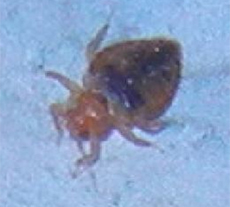 Adult bed bugs are small, flattened oval shaped insects ranging from light brown to deep reddish-brown in colour. Adults range in size from 4-10mm and the immature stages can be as small as 1mm and much lighter in colour. All stages will darken in colour as they feed on blood. The eggs are about the size of a pin head and white in colour. Because of their size and flattened bodies, they are able to hide in very small crevices, making detection difficult for the untrained eye.
Adult bed bugs are small, flattened oval shaped insects ranging from light brown to deep reddish-brown in colour. Adults range in size from 4-10mm and the immature stages can be as small as 1mm and much lighter in colour. All stages will darken in colour as they feed on blood. The eggs are about the size of a pin head and white in colour. Because of their size and flattened bodies, they are able to hide in very small crevices, making detection difficult for the untrained eye.
Behaviour
Bed bugs are parasitic insects that feed on the blood of humans and animals. They are primarily active at night, but are not exclusively nocturnal. They are unable to fly or jump, so they rely on being transported with the movement of infested items. In apartments they are able to crawl between units, with the ability to infest entire buildings. They typically hide close to beds or bedroom furniture where they can hide and feed regularly, being attracted to the heat and carbon dioxide we give off as we sleep. With adequate conditions and available food sources, bed bugs are prolific breeders with an adult female laying 2-4 eggs per day.
Bed bug bites are easily mistaken for a mosquito or flea bite and the reaction differs greatly among people being bitten. Some people will barely notice the bites, whereas others will develop rashes and painful skin irritations. While bed bugs have not been implicated in the spread of disease, an infestation of these creatures takes its toll on your household. At PROTEC we have found that the psychological effects of having bedbugs in your home are often as problematic as the insects themselves. While good sanitation will help minimize an infestation, a bed bug problem is not an indication of the cleanliness of your home.
Control
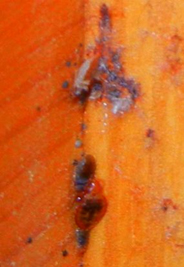 Bed bug control is seldom achieved with one application technique. Most currently available insecticides will have limited success unless combined with other control techniques. At Protec, we employ vacuuming, heat, steam and insecticides to eliminate the infestation. Success of the treatment is greatly enhanced with proper preparation as poorly prepared premises should not be treated. Protec technicians will help you to ensure you have properly prepared for treatment.
Bed bug control is seldom achieved with one application technique. Most currently available insecticides will have limited success unless combined with other control techniques. At Protec, we employ vacuuming, heat, steam and insecticides to eliminate the infestation. Success of the treatment is greatly enhanced with proper preparation as poorly prepared premises should not be treated. Protec technicians will help you to ensure you have properly prepared for treatment.
Despite having multiple techniques available to control bed bugs, the biggest key is to be thorough. When choosing a pest control provider insure that they allow enough time to do a complete and proper treatment and follow up inspection.
Beetles, Bugs, Earwigs & Silverfish Removal
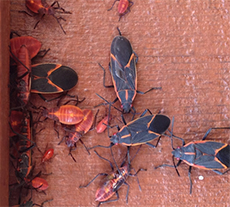 There are several nuisance pests that will invade homes, particularly in the warmer months. Boxelder bugs (pictured at left), earwigs, lady bugs, stink bugs, sow bugs, pill bugs and silverfish are all common insect pests in and around structures. Your Protec technician can identify your problem and provide the safest and best solution. To identify unknown pests, Protec is always happy to receive a picture through email or text.
There are several nuisance pests that will invade homes, particularly in the warmer months. Boxelder bugs (pictured at left), earwigs, lady bugs, stink bugs, sow bugs, pill bugs and silverfish are all common insect pests in and around structures. Your Protec technician can identify your problem and provide the safest and best solution. To identify unknown pests, Protec is always happy to receive a picture through email or text.
Carepnter Ant Removal
Carpenter ants can become active in homes as early as January, but typically sightings of these large, black ants start as spring weather approaches. With their ability to cause structural damage to your home, carpenter ants require the guaranteed services of Protec Pest Control. Call now to have an experienced technician assess your ant problem.
Appearance
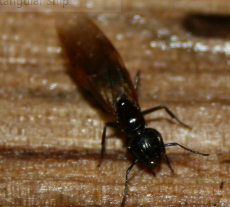 Carpenter ants are typically described as a large black ant. Their size can range from 6mm to 25mm and they are dull black or black with a rusty red thorax (mid-section). Ants of all sizes (queens, males, major and minor workers) can be found within a single colony or nest. This can deceive some homeowners into thinking they have more than one ant species infesting their home. Carpenter ants are completely different from termites in both appearance and habits.
Carpenter ants are typically described as a large black ant. Their size can range from 6mm to 25mm and they are dull black or black with a rusty red thorax (mid-section). Ants of all sizes (queens, males, major and minor workers) can be found within a single colony or nest. This can deceive some homeowners into thinking they have more than one ant species infesting their home. Carpenter ants are completely different from termites in both appearance and habits.
Diet
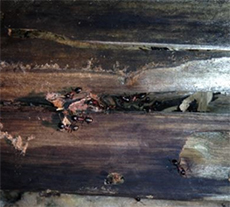 Carpenter ants are omnivorous. Their diet is wide ranging, including most types of meat and plant material. Fruits, plant juices, honey, sugar, meat, fat, grease, living and dead insects are all common carpenter ant foods. Most of our household food items would fit into the carpenter ant diet, which leads to foraging ants in the kitchen as an early sign of carpenter ant problems.
Carpenter ants are omnivorous. Their diet is wide ranging, including most types of meat and plant material. Fruits, plant juices, honey, sugar, meat, fat, grease, living and dead insects are all common carpenter ant foods. Most of our household food items would fit into the carpenter ant diet, which leads to foraging ants in the kitchen as an early sign of carpenter ant problems.
Only about ten percent of the nest is ever out foraging, so the ants in the kitchen are not likely the source of the infestation. These ants will also travel up to a hundred metres from the nest to look for food and are primarily active at night, so killing the foraging ants will not solve the problem.
Behaviour
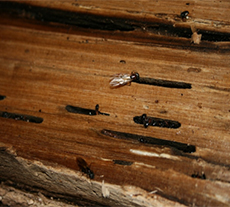 In a natural setting, carpenter ants are a beneficial species, assisting with the breakdown and regeneration of forests. They establish their colonies in trees, tunnelling out the wood to expand their nests. Trees with decay, rot or moisture problems are prime targets for carpenter ants. With wood as the primary construction material for homes, our houses provide great alternate hosts for carpenter ants. Homes with moisture or humidity issues provide attractive sites for ant nests, particularly if they are in an area of mature trees. For this reason, carpenter ants are considered the most destructive common insect pest in Ontario.
In a natural setting, carpenter ants are a beneficial species, assisting with the breakdown and regeneration of forests. They establish their colonies in trees, tunnelling out the wood to expand their nests. Trees with decay, rot or moisture problems are prime targets for carpenter ants. With wood as the primary construction material for homes, our houses provide great alternate hosts for carpenter ants. Homes with moisture or humidity issues provide attractive sites for ant nests, particularly if they are in an area of mature trees. For this reason, carpenter ants are considered the most destructive common insect pest in Ontario.
Unlike termites, carpenter ants do not eat or digest wood. They will tunnel out wood to build their nests and expel sawdust- like material called frass. While carpenter ants will initially infest damaged wood, their colonies will move into sound wood as the nest expands, causing structural damage. A carpenter ant colony can survive for many years and can contain thousands of ants, expanding to multiple nests within a structure. In Ontario, carpenter ants are active along exterior ant trails from April to October, but can be sighted year round in heated structures. Mature nests will produce winged reproductives as early as January in homes, but more typically in the early spring. A sighting of large, winged ants in your home while it is still cold outside, is a sure sign of a mature nest in the structure.
Commonly Asked Questions
Do carpenter ants infest new homes?
We have found carpenter ants in all ages of structures, but more established neighbourhoods are more prone to carpenter ant problems. New homes or cottages in areas of established trees can also develop satellite nests from the surrounding landscape.
How do you find the nest?
Experience. PROTEC technicians have several tools at their disposal to narrow down the location of possible nest sites. Thorough inspection and customer observations will provide important clues as to the nest locations. Microinjection equipment is a necessity for a complete treatment.
How much does carpenter ant treatment cost?
While the large corporate pest control services will tell the homeowner that carpenter ants require an expensive multi-service renewing contract, PROTEC will tailor the treatment to your needs. In some circumstances, a spot treatment with a short guarantee period is all that’s required. In others, ongoing service may be preferred by the homeowner. When you call PROTEC, you always get an actual service technician on the phone to assess your needs and are your call is not pushed through a call centre.
How much structural damage will carpenter ants do?
PROTEC technicians have found damage to structural timbers and wall studs as well as to cosmetic trim. Some nests have been located without any structural damage at all. Without opening wall cavities, the full extent of the damage is hard to determine. Carpenter ant damage often goes undiscovered until renovations are started.
Are pesticide applications for carpenter ants dangerous?
When properly applied by licensed professionals, pesticides are effective and safe. PROTEC employs Integrated Pest Management techniques utilizing the least amount of pesticide to achieve effective control.
What can I do to protect my home from carpenter ants?
Remove sources of moisture in the home such as leaks and condensation. Replacing damaged wood will not eliminate existing infestation, but will help discourage new ones. On the exterior: inspect your trees, landscape timbers and any stumps for signs of decay and ant activity. Seal foundation cracks, remove wood/soil contact points and store firewood off the ground, away from the house.
Do ant baits work on carpenter ants?
Store bought ant baits have almost no effect on a carpenter ant infestation. While a few foraging ants may be killed off, the nest is not affected.
Cluster Flies Removal
While they don’t pose a potential health risk like some other flies, the nuisance of having cluster flies can be unbearable for the homeowner. Windows, walls and light fixtures covered in cluster flies can look like a scene from a bad horror movie. These sluggish flies can appear to be common house flies, but are slower, larger and darker in colour. Their name comes from their habit of “clustering” on the sunny side of structures before entering in the fall.
Behaviour
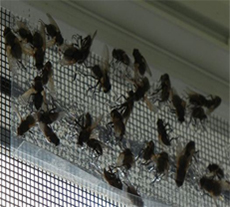 The behaviour of cluster flies varies greatly from other types of flies. They do not breed, lay eggs or feed indoors. Their eggs are laid in the soil where the larvae become parasites on earthworms. They then pupate in the soil and emerge as adult flies to start the cycle again. The process from eggs to adult can take anywhere from three to five weeks and can be completed as many as four times in a season, depending on conditions. They are a long lived fly, capable of surviving through their winter dormancy in a structure.
The behaviour of cluster flies varies greatly from other types of flies. They do not breed, lay eggs or feed indoors. Their eggs are laid in the soil where the larvae become parasites on earthworms. They then pupate in the soil and emerge as adult flies to start the cycle again. The process from eggs to adult can take anywhere from three to five weeks and can be completed as many as four times in a season, depending on conditions. They are a long lived fly, capable of surviving through their winter dormancy in a structure.
Cluster flies become a nuisance when they overwinter in homes, laying dormant in attics and wall voids. They enter the home in the fall through cracks, soffits, vents and small gaps in the building after clustering on the exterior. They will typically emerge in early spring or on warm sunny days in the winter and are strongly attracted to light, often filling light fixtures and windows with dead flies. The dead flies in an attic space can provide food for mice and may also attract secondary pests such as larder beetles.
Control
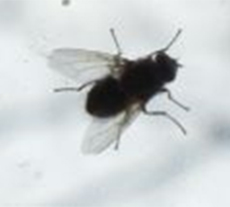 Sealing of cracks and screening of openings will aid in excluding flies from the structure and chemical treatments need to be properly timed. As cluster flies are most active in the spring and fall, treatment is timed to control the flies during these seasons. Spring treatment is aimed at reducing numbers on the interior, while fall treatment is directed at excluding the flies from entering for the winter. Both treatments involve treatment of the attic space whenever possible. Your Protec technician can provide you with treatment options and answer any of your questions regarding cluster flies.
Sealing of cracks and screening of openings will aid in excluding flies from the structure and chemical treatments need to be properly timed. As cluster flies are most active in the spring and fall, treatment is timed to control the flies during these seasons. Spring treatment is aimed at reducing numbers on the interior, while fall treatment is directed at excluding the flies from entering for the winter. Both treatments involve treatment of the attic space whenever possible. Your Protec technician can provide you with treatment options and answer any of your questions regarding cluster flies.
Cockroach Removal
The cockroach is one of the most common structural pests in the world. While there are thousands of known species worldwide, only a few are found in Ontario dwellings. German Cockroaches, Oriental Cockroaches, American Cockroaches and Wood Roaches are common pests, but the majority of cockroach infestations in the GTA involve the German cockroach.
Appearance and Habits
 The most common cockroach species encountered locally, the German cockroach, is about 1.3 to 1.6 cm long, light brown in colour with two dark parallel stripes running from the head to the wings. They are primarily nocturnal, however can be active during the day, particularly with large infestations. Homes, apartments, restaurants and food plants are all favourite locations for cockroaches. However they will infest any area with available food, water and harborage. The warm, humid conditions inside structures, especially around plumbing areas can provide ideal cockroach harborage.
The most common cockroach species encountered locally, the German cockroach, is about 1.3 to 1.6 cm long, light brown in colour with two dark parallel stripes running from the head to the wings. They are primarily nocturnal, however can be active during the day, particularly with large infestations. Homes, apartments, restaurants and food plants are all favourite locations for cockroaches. However they will infest any area with available food, water and harborage. The warm, humid conditions inside structures, especially around plumbing areas can provide ideal cockroach harborage.
Cockroaches have the potential to passively spread disease and contaminate food by walking through garbage and sewers and then onto food or food surfaces. They can also negatively affect people with asthma and can cause allergic reactions. While they have food preferences, cockroaches will eat virtually anything organic that is available. As well, a cockroach infestation does not necessarily indicate poor sanitation; however regular deep cleaning will aid in control of the problem.
Control
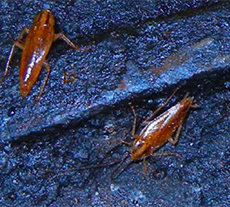 Control of cockroaches, especially in commercial establishments takes a multi-faceted approach and cooperation between client and technician. The cockroach’s reproductive prowess, adaptability, resistance to pesticides and ability to go long periods without food make knowledgeable service technicians a must. Protec technicians have spent many years solving difficult cockroach problems.
Control of cockroaches, especially in commercial establishments takes a multi-faceted approach and cooperation between client and technician. The cockroach’s reproductive prowess, adaptability, resistance to pesticides and ability to go long periods without food make knowledgeable service technicians a must. Protec technicians have spent many years solving difficult cockroach problems.
Chemical sprays and dusts as well as baiting can all provide control when applied in the safest and most effective manner. Eliminating harborage and food supplies through proper sanitation is a necessary step in cockroach control. Whether you require a single treatment or ongoing service, call Protec today to have a cockroach control program designed to your specific needs.
Mice & other Rodent Removal
Droppings, damaged food packaging and scratching sounds in the walls or ceilings can all be indicators of a rodent infestation. Both rats and mice will invade structures looking for food and shelter and are destructive once inside. They have the potential to spread disease, damage food, insulation, wiring, equipment and even set off alarm systems.
Appearance and Behaviour
 The house mouse is light brown to grey in colour and is a very common pest worldwide. The deer mouse is light brown with a white under belly. The meadow vole is dark brown with a thicker body and short tail. All three species of rodents are known to enter homes and businesses, but the house mouse is most likely to breed and remain indoors. The mouse is a prolific breeder when conditions are right and is a huge concern in the food industry. The most common rat in Ontario is the Norway rat which full grown is typically about 0.5kg. They prefer to nest in their extensive tunnel systems in the ground, but will adapt to living in our dwellings.
The house mouse is light brown to grey in colour and is a very common pest worldwide. The deer mouse is light brown with a white under belly. The meadow vole is dark brown with a thicker body and short tail. All three species of rodents are known to enter homes and businesses, but the house mouse is most likely to breed and remain indoors. The mouse is a prolific breeder when conditions are right and is a huge concern in the food industry. The most common rat in Ontario is the Norway rat which full grown is typically about 0.5kg. They prefer to nest in their extensive tunnel systems in the ground, but will adapt to living in our dwellings.
Rodents will be most active at night to avoid predators and people. They have a wide ranging diet and can chew through packaging to get to a food source. Garbage, pet food and bird seed are all common food sources once rodents are inside a home.
Control
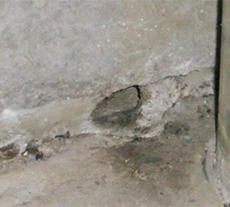 Identifying the rodent will determine the control method. Proper and safe placement of commercial rodenticides is the quickest and most effective way to eliminate a house mouse problem. Rat infestations need to be assessed on an individual basis, normally involving trapping and exclusion. Protec technicians use the safest and best products always placed in locked, tamper resistant stations with concern for people and pets. Our rodent control work always involves a thorough inspection of the premises and exterior to determine entry points. Protec will seal small openings and make recommendations for long term rodent exclusion. Our rodent work typically includes a one year guarantee.
Identifying the rodent will determine the control method. Proper and safe placement of commercial rodenticides is the quickest and most effective way to eliminate a house mouse problem. Rat infestations need to be assessed on an individual basis, normally involving trapping and exclusion. Protec technicians use the safest and best products always placed in locked, tamper resistant stations with concern for people and pets. Our rodent control work always involves a thorough inspection of the premises and exterior to determine entry points. Protec will seal small openings and make recommendations for long term rodent exclusion. Our rodent work typically includes a one year guarantee.
Spider Removal
While well-known to be beneficial as a predator on insects, spiders can become an unwanted pest as their numbers increase in and around your home or cottage. The mess from their webbing and excrement becomes an ongoing cleanup chore and can eventually discolour siding and trim. Spiders will often enter buildings in firewood, through open doors and windows or poorly fitting screens.
Appearance and Behaviour
 Spiders are known by their two body segments and eight legs, differentiating them from insects. Common spiders found in Ontario homes are cellar spiders, wolf spiders and house spiders. While there are many other species of spiders found in homes, very few pose any hazard to humans. Spiders are generally nocturnal and they are unlikely to bite unless trapped or grabbed. They are long-lived, typically 1-2 years and will enter structures in all warm seasons. Their webbing is the most obvious sign of a spider problem; however, some spiders hunt without using a web and have to capture their prey.
Spiders are known by their two body segments and eight legs, differentiating them from insects. Common spiders found in Ontario homes are cellar spiders, wolf spiders and house spiders. While there are many other species of spiders found in homes, very few pose any hazard to humans. Spiders are generally nocturnal and they are unlikely to bite unless trapped or grabbed. They are long-lived, typically 1-2 years and will enter structures in all warm seasons. Their webbing is the most obvious sign of a spider problem; however, some spiders hunt without using a web and have to capture their prey.
CONTROL
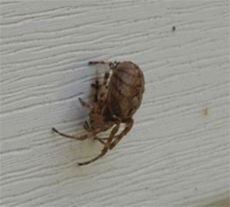 As it is always better to avoid using pesticides whenever possible inside your home or cottage, an integrated approach to spider control is the Protec method. Thorough indoor vacuuming, combined with an exterior insecticide application will normally give good control, provided the right insecticide is used on the exterior. Slow release, micro-encapsulated insecticides give the best long term control. They also have the added bonus of controlling many of the insects that spiders feed on, reducing their food source. Exterior insecticide applications will break down when exposed to sunlight and weather conditions, making two spring/summer treatments recommended. Call your Protec professional today to solve your spider problem.
As it is always better to avoid using pesticides whenever possible inside your home or cottage, an integrated approach to spider control is the Protec method. Thorough indoor vacuuming, combined with an exterior insecticide application will normally give good control, provided the right insecticide is used on the exterior. Slow release, micro-encapsulated insecticides give the best long term control. They also have the added bonus of controlling many of the insects that spiders feed on, reducing their food source. Exterior insecticide applications will break down when exposed to sunlight and weather conditions, making two spring/summer treatments recommended. Call your Protec professional today to solve your spider problem.
Wasp, Hornet & Bee Removal
Bees, wasps and hornets are well known flying insect pests that will often disturb summer outdoor activities with their foraging and aggressive behavior. Their painful and potentially dangerous stings are a late summer hazard and are a serious health risk for those with allergies to wasp venom.
Appearance and Behaviour
 Yellowjackets are the most commonly encountered wasp and are easily identifiable by their yellow striped abdomen. They will build nests in the ground, in trees, eaves, attics, under siding and in gaps in brick. They will aggressively defend nests as will Bald Faced Hornets. These large hornets are identified by their white face and white striped abdomen as well as their large hanging nests. Paper Wasps are similar in size and appearance to yellowjackets, but less aggressive. They will however, give a nasty sting when threatened. Less likely to sting, but more likely to cause damage is the Carpenter bee. These large bees resemble bumble bees, but with a smooth black abdomen. They nest in wood, often on the underside of decks and expel sawdust from their entry holes. The holes these bees create are impressive by their perfectly round shape, easily mistaken for a hole made by a drill bit. An experienced exterminator should confuse none of these flying pests with the beneficial honey bee.
Yellowjackets are the most commonly encountered wasp and are easily identifiable by their yellow striped abdomen. They will build nests in the ground, in trees, eaves, attics, under siding and in gaps in brick. They will aggressively defend nests as will Bald Faced Hornets. These large hornets are identified by their white face and white striped abdomen as well as their large hanging nests. Paper Wasps are similar in size and appearance to yellowjackets, but less aggressive. They will however, give a nasty sting when threatened. Less likely to sting, but more likely to cause damage is the Carpenter bee. These large bees resemble bumble bees, but with a smooth black abdomen. They nest in wood, often on the underside of decks and expel sawdust from their entry holes. The holes these bees create are impressive by their perfectly round shape, easily mistaken for a hole made by a drill bit. An experienced exterminator should confuse none of these flying pests with the beneficial honey bee.
Wasps and hornets become a real problem in late summer when their nests are big and they require large amounts of carbohydrates for the colony. This is when they invade your garbage can, deck, patio or picnic in search of sweets.
Control
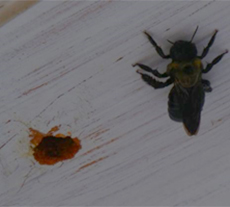 The solution to any problem with bees, wasps or hornets is the destruction of the nest. While some store bought sprays may work on a small, exposed nest, large nests or hidden nests require professional service. Many homeowners have plugged wasp entry holes on their home only to trap an active wasp nest inside the house. The other challenge with wasps is the distance they will fly to forage. A nest in a neighbouring yard or home can leave you with the foraging wasps. Call Protec today for guaranteed wasp nest extermination.
The solution to any problem with bees, wasps or hornets is the destruction of the nest. While some store bought sprays may work on a small, exposed nest, large nests or hidden nests require professional service. Many homeowners have plugged wasp entry holes on their home only to trap an active wasp nest inside the house. The other challenge with wasps is the distance they will fly to forage. A nest in a neighbouring yard or home can leave you with the foraging wasps. Call Protec today for guaranteed wasp nest extermination.
Late Summer Bee and Wasp Control
